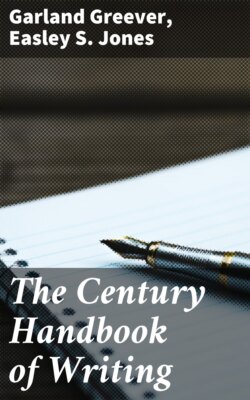Читать книгу The Century Handbook of Writing - Garland Greever - Страница 14
Transitions
ОглавлениеThe state of mind of a writer is not the state of mind of his reader. The writer knows his ideas, and has spent much time with them. The reader meets these ideas for the first time, and must gather them in at a glance. The relation between two ideas may be clear to the writer, and not at all clear to the reader. Therefore,
8. In passing from one thought to another, make the connection clear. If necessary, insert a word, a phrase, or even a sentence, to carry the reader safely across.
Space transition needed: We were surprised to see a house in the distance, but we went to the door and knocked. [This sentence does not give a reader the effect of distance.]
Better: We were surprised to see a house in the distance. But we hastened toward it with thoughts of a warm meal and a good lodging. We entered the yard, and went up to the door, and knocked.
Exterior-interior transition needed: We noticed that the house was built of cobblestones. There was a broad window from which we could look out upon the small stream that dashed down the rocky hillside.
Better: We noticed that the house was built of cobblestones. We went inside, and found that the living room was large and airy. There was a broad window from which we could look out upon the small stream that dashed down the rocky hillside.
Cause transition lacking: The Romans were great road-builders. They wished to maintain their empire.
Better: The Romans were great road-builders, because means of moving troops quickly were necessary to the maintenance of their empire.
General-to-particular transition needed: Modern machinery often makes men its slaves. Last summer I worked for the Chandler Company. [This gap in thought occurs oftenest between the first two sentences of a paragraph or theme.]
Better: Modern machinery often makes men its slaves. This truth is well illustrated by my own experience. Last summer I worked for the Chandler Company.
Transition to be improved by changing order: A careless trainer may spoil a good colt. A good horse can never be made of a vicious colt. [Here the order of ideas is: "Trainer … colt. Horse … colt." Turn the last sentence end for end.]
Better: A careless trainer may spoil a good colt. And a vicious colt can never be made a good horse. [Now the order of ideas is "Trainer … colt. Colt … horse."]
Transition to be improved by removal of a disturbing element: Our class in physics last week visited a pumping station in which the Corliss type of steam engine is used. The engines are manufactured by the Allis-Chalmers Company of Milwaukee, Wisconsin. This type of engine is used because it has several advantages. [The italicized sentence should be omitted here, and used later in the theme.]
Note.—The divisions of thought within a paragraph may likewise be indicated by connectives: however, on the other hand, equally important, another interesting problem is, for this reason, the remedy for this, so much for, it remains to mention, of course I admit, finally. (For a longer list see 36.) Such phrases are also useful in linking one paragraph to another.
When a student first learns the art, he is likely to use transition phrases in excess, and produce something like the following: "When I have to write a theme, I first think of my subject. As soon as I have my subject, I take out my paper. On the paper I then make a rough outline." This abuse of transition causes an overlapping of thought, like shingles laid three inches to the weather. An abrupt transition is better than wordiness.
Exercise:
1 The shore looked far off. Then we reached it.
2 A light snow was falling last night. This is a good day for hunting rabbits.
3 A dollar is often a large sum. I sold newspapers when I was a boy.
4 Many English words still preserve their old meanings. There is the teller in the bank.
5 We had to walk half a mile across the pastures in the fresh morning air. Exercise indoors does not arouse much zest or enthusiasm.
